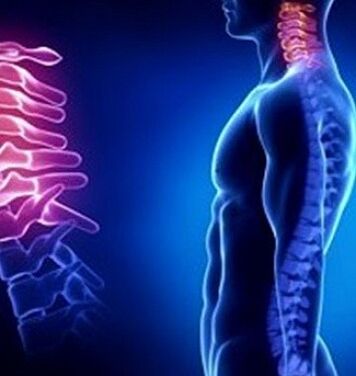
With osteochondrosis, there is a gradual destruction of spinal tissue, which leads to a violation of its function. Usually such degenerative processes take place in his most mobile departments. Osteochondrosis of the cervix is more common in young people. The instability of this department, combined with the increase in physical activity, explains its sensitivity to various dystrophic injuries and processes. In 3 out of 10 cases, it is the one that causes the sudden headache. Osteochondrosis provokes a metabolic disorder in the spine. Because of this, the disks in it come out and then crack.
Symptoms
Some signs may indicate dystrophic changes in the spine. Depending on the stage of the disease, they are more pronounced or weaker. Osteochondrosis of the cervix has the following symptoms:
- Pain in neck, neck, shoulder. Reinforces even with a light load.
- Numbness in the limbs.
- Cracking when turning the neck.
- Headache localized mainly in the occiput and temples.
- Fainting, chronic fatigue.
- Tinnitus, hearing loss.
- Loss of visual acuity.
Osteochondrosis of the cervix can also be indicated by pulling pain in the heart region. The patient often has angina pectoris-like sensations. When the spinal cord is caught, other disorders also occur. For example, loss of tongue sensitivity or decreased neck muscle tone, breathing problems. If treatment is not prescribed in time, the patient may develop an extension or hernia.
There are four stages of osteochondrosis. The first is characterized by instability in the intervertebral discs. In the second, extensions are considered the main signs. In this case, the gaps between the vertebrae become smaller. There is a pain syndrome, which can be associated with tight nerve roots.
In the third stage, destruction of the fibrous ring occurs, which is an integral part of the intervertebral disc. This is why it then deforms. A patient with stage IV osteochondrosis of the cervix feels severe pain with each movement. It should be noted that a decrease in its intensity does not indicate recovery. On the contrary, it indicates that the process of forming osteophytes connecting the vertebrae has begun. As a rule, this leads to disability. Treatment is prescribed on the basis of clinical signs and the stage of development of the pathology.
Causes of the disease

Sedentary work is most often accompanied by osteochondrosis of the cervix. This section of the spine is quite compact, and therefore even a slight muscle tension in it leads to compression of the nerve endings and blood vessels. Against this background, osteophytes often form, which only worsens the situation. In addition to a sedentary lifestyle, the disease can be caused by:
- metabolic disorders;
- malnutrition;
- deposition of salt in the cervical spine;
- hypothermia;
- hereditary predisposition;
- cervical spine injuries;
- rheumatism.
The cause of the development of the disease can also be a curvature of the spine or excess weight. The risk group includes people with poor physical abilities or athletes who make mistakes in the training process.
Which doctor treats osteochondrosis of the cervix?
To avoid developing complications at the first signs of spinal nerve root constriction, you should seek help from a medical specialist. Osteochondrosis of the cervix and its symptoms are treated by neurologists, chiropractors, osteopaths.
Furthermore, you may need to consult a neurosurgeon, traumatologist, therapist, cardiologist. To differentiate the diagnosis, the doctor analyzes the patient's complaints. At this stage, he asks the patient the following questions:

- When did neck pain first appear?
- Do other symptoms accompany cervical osteochondrosis?
- Is the patient's professional activity related to lifting weights or keeping the neck in a stationary position for a long time?
- What is the patient's fitness level?
- Does the patient have signs of neurological disorders?
To assess the condition of the spine, the doctor prescribes x-ray, CT or MRI. Depending on the symptoms and the stage of the disease, treatment may include massage, swimming and exercise therapy. Local destruction processes are affected by acupuncture. With severe pain syndrome, the doctor prescribes anesthetics. Muscle tension is relieved by muscle relaxants. In advanced cases, when the patient has a hernia that compresses the roots of the spinal cord, surgical intervention is necessary.
What if the disease is not treated?
In the absence of qualified medical care, the patient eventually develops chronic pain in the cervical spine. Radiates to the upper and lower limbs, which is fraught with paralysis. As osteophytes grow, they suppress nerve channels, veins, and arteries. This can disrupt the cerebral circulation process. Often this provokes ischemia and stroke in the spine. The patient also worsens vision, hearing, migraines and vegetative vascular dystonia.
By studying cervical osteochondrosis and its clinical symptoms, doctors often diagnose radiculopathy. It leads to partial or complete loss of vertebral mobility. The appearance of irritations is a reason for the hospitalization of the patient. The most severe consequence of cervical osteochondrosis is considered to be spinal cord compression. The risk of death in this case is quite high. To avoid the development of complications, it is necessary to consult a doctor as soon as possible. The way it works should be smooth. Every day you should do special gymnastics, and if possible, morning exercises.


























